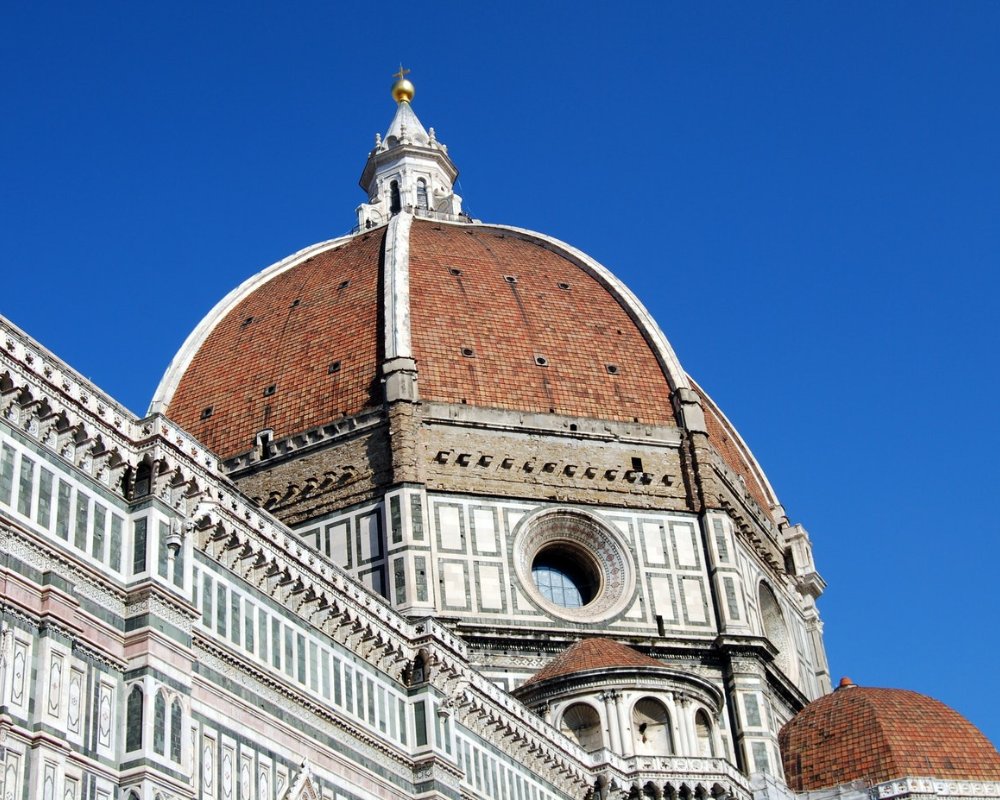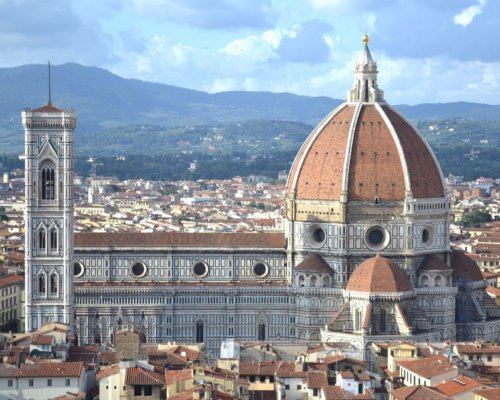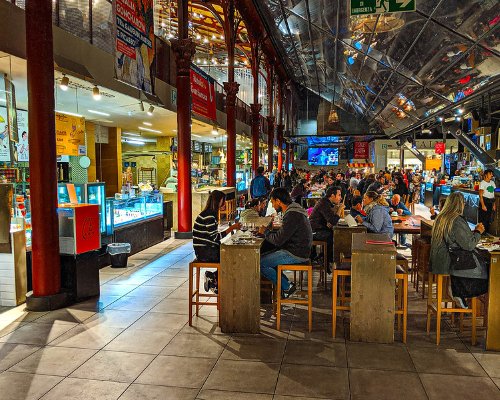A 10-stop itinerary to discover the city by foot
All you need to follow this itinerary will be a comfortable pair of shoes and the desire to explore Florence by foot through art, taste and sport.
The beauty of a slow walk – alone or in group – trough the best-known tourist destinations and a few lesser-known places is this: enjoy every corner of the city with calm, without having to run among the crowd e with a few relaxing breaks in the districts lesser-known by mass tourism.
Let's start this sustainable walk now, which can be done every season and at any time of the day, from Santa Maria Novella train station.
Florence train station is the ideal place to start our walk into the city: you can arrive by train, bus, tramway or even by car - taking advantage of the underground car park (for a fee).
The train station is of great historical and architectural value: designed by Giovanni Michelucci - and inaugurated on October 30, 1935 - it has always dialogued with the surrounding urban fabric, especially with Santa Maria Novella Church, which it “contrasts” with through the horizontality of its form.
Florence train station is the ideal place to start our walk into the city: you can arrive by train, bus, tramway or even by car - taking advantage of the underground car park (for a fee).
The train station is of great historical and architectural value: designed by Giovanni Michelucci - and inaugurated on October 30, 1935 - it has always dialogued with the surrounding urban fabric, especially with Santa Maria Novella Church, which it “contrasts” with through the horizontality of its form.
The second stop to reach, along the busy Via de' Cerretani, is Piazza del Duomo.
If this is your first time visiting Florence, you will remain speechles: at a single glance, you will see the main monuments of the historic centre – declared a UNESCO World Heritage Site – such as the Santa Maria del Fiore Cathedral, the impressive Brunelleschi’s Dome – symbol of Florence – the massive Giotto’s Bell Tower and the ancient Baptistery of San Giovanni, a romanesque jewel, adorned with bronze doors by Ghiberti and Andrea Pisano.
The second stop to reach, along the busy Via de' Cerretani, is Piazza del Duomo.
If this is your first time visiting Florence, you will remain speechles: at a single glance, you will see the main monuments of the historic centre – declared a UNESCO World Heritage Site – such as the Santa Maria del Fiore Cathedral, the impressive Brunelleschi’s Dome – symbol of Florence – the massive Giotto’s Bell Tower and the ancient Baptistery of San Giovanni, a romanesque jewel, adorned with bronze doors by Ghiberti and Andrea Pisano.
Passing through San Lorenzo district, animated by many shops and restaurants, you will arrive at the famous Mercato Coperto, housed in a particular liberty structure made by iron and glass. Getting lost among the scents and flavours of this place is one of the best food experiences you can have in Florence: on the ground floor, there is a large market selling fruit, vegetables, fresh pasta and typical Tuscan products - such as lampredotto and tripe - while on the upper floor you can eat products prepared by the so-called “artisans of taste”, directly on site.
Take your time to taste some traditional dishes or relax at the cafeteria tables.
Passing through San Lorenzo district, animated by many shops and restaurants, you will arrive at the famous Mercato Coperto, housed in a particular liberty structure made by iron and glass. Getting lost among the scents and flavours of this place is one of the best food experiences you can have in Florence: on the ground floor, there is a large market selling fruit, vegetables, fresh pasta and typical Tuscan products - such as lampredotto and tripe - while on the upper floor you can eat products prepared by the so-called “artisans of taste”, directly on site.
Take your time to taste some traditional dishes or relax at the cafeteria tables.
Via dei Calzaiuoli is a street that connects the Piazza Duomo to Piazza della Signoria: in the past, it was the link between ecclesiastical (Cathedral) and political (Palazzo Vecchio) power.
Today, it is one of the most elegant and busiest streets in the centre, where, in addition to numerous shops, you can admire the splendid Church and Museum of Orsanmichele on whose external pillars you can find copies of the fourteen statues of the patron saints, sculpted by the hands of Donatello, Verrocchio, Ghiberti, Giambologna and Nanni di Banco - the original sculptures have been transferred to the Museum of Orsanmichele, on the upper floors of the building.
Via dei Calzaiuoli is a street that connects the Piazza Duomo to Piazza della Signoria: in the past, it was the link between ecclesiastical (Cathedral) and political (Palazzo Vecchio) power.
Today, it is one of the most elegant and busiest streets in the centre, where, in addition to numerous shops, you can admire the splendid Church and Museum of Orsanmichele on whose external pillars you can find copies of the fourteen statues of the patron saints, sculpted by the hands of Donatello, Verrocchio, Ghiberti, Giambologna and Nanni di Banco - the original sculptures have been transferred to the Museum of Orsanmichele, on the upper floors of the building.
Piazza della Signoria has been, since the Middle Ages, the beating heart of the city's politics, in fact, even today it is still the main seat of the Municipality of Florence.
The square hosts some of the best-known buildings in Florence: Palazzo Vecchio with its characteristic tower - designed by Arnolfo di Cambio - and the Loggia dei Lanzi, an open-air sculpture museum with masterpieces such as Benvenuto Cellini's Perseo (Perseus) and Giambologna's Ratto delle Sabine (The Rape of the Sabine Women).
Near to the square, there is one of the most important and well-known museums: the Uffizi Gallery.
A visit to the museum deserves an exclusive day because it hosts masterpieces that are unique in the world, but it will be equally interesting to see the palace that hosts the gallery - built by Giorgio Vasari in 1560 on the orders of Cosimo I de' Medici - and the Corridoio Vasariano, the extraordinary elevated walkway which connects Palazzo Vecchio with Palazzo Pitti, on the other bank of the Arno, crossing Ponte Vecchio and the Boboli Gardens.
Piazza della Signoria has been, since the Middle Ages, the beating heart of the city's politics, in fact, even today it is still the main seat of the Municipality of Florence.
The square hosts some of the best-known buildings in Florence: Palazzo Vecchio with its characteristic tower - designed by Arnolfo di Cambio - and the Loggia dei Lanzi, an open-air sculpture museum with masterpieces such as Benvenuto Cellini's Perseo (Perseus) and Giambologna's Ratto delle Sabine (The Rape of the Sabine Women).
Near to the square, there is one of the most important and well-known museums: the Uffizi Gallery.
A visit to the museum deserves an exclusive day because it hosts masterpieces that are unique in the world, but it will be equally interesting to see the palace that hosts the gallery - built by Giorgio Vasari in 1560 on the orders of Cosimo I de' Medici - and the Corridoio Vasariano, the extraordinary elevated walkway which connects Palazzo Vecchio with Palazzo Pitti, on the other bank of the Arno, crossing Ponte Vecchio and the Boboli Gardens.
Walking along the Lungarno Anna Maria Luisa De' Medici, you will arrive in just a few steps on Ponte Vecchio, the oldest crossing of the Arno, which in the 15th century hosted the shops of fishmongers, butchers and tanners: in 1593, however, by order of Ferdinand I - who could not stand the unpleasant smells under the windows of the Corridoio Vasariano, where he passed every day - the spaces were occupied by goldsmiths and jewellers.
Even today there are only goldsmiths' shops on the bridge, making Ponte Vecchio the perfect destination for a day of true Florentine shopping.
Walking along the Lungarno Anna Maria Luisa De' Medici, you will arrive in just a few steps on Ponte Vecchio, the oldest crossing of the Arno, which in the 15th century hosted the shops of fishmongers, butchers and tanners: in 1593, however, by order of Ferdinand I - who could not stand the unpleasant smells under the windows of the Corridoio Vasariano, where he passed every day - the spaces were occupied by goldsmiths and jewellers.
Even today there are only goldsmiths' shops on the bridge, making Ponte Vecchio the perfect destination for a day of true Florentine shopping.
Continuing along the path of Corridoio Vasariano, you will arrive at the Pitti Palace, the palace of the lords of Florence and Tuscany: here lived the Medici, then the Lorraine and after the Unification of Italy the Savoys, during the years of Florence as capital city.
Today, the Pitti Palace is one of the most important museum venues in the city: with the Palatine Gallery, a rich picture gallery with a remarkable collection of Renaissance paintings - including works by Raphael, Caravaggio and Titian - as well as the Royal Apartments, decorated with 16th-century furnishings.
Inside the palace, there is also the Modern Art Gallery with works of art from the late 18th century to the early decades of the 20th century.
Continuing along the path of Corridoio Vasariano, you will arrive at the Pitti Palace, the palace of the lords of Florence and Tuscany: here lived the Medici, then the Lorraine and after the Unification of Italy the Savoys, during the years of Florence as capital city.
Today, the Pitti Palace is one of the most important museum venues in the city: with the Palatine Gallery, a rich picture gallery with a remarkable collection of Renaissance paintings - including works by Raphael, Caravaggio and Titian - as well as the Royal Apartments, decorated with 16th-century furnishings.
Inside the palace, there is also the Modern Art Gallery with works of art from the late 18th century to the early decades of the 20th century.
Piazza Santo Spirito is one of the most beautiful and lively squares in the city and is dominated by the facade of the basilica designed by Brunelleschi.
Picturesque, with craftsmen's workshops and artists' studios, restaurants and clubs open day and night, it is one of the symbols of the Oltrarno and a favourite meeting place for locals and tourists alike.
It is the right place to take a break in one of the many cafés that enliven it.
The Basilica hosts Michelangelo's wooden crucifix and valuable works by Filippino Lippi, Sansovino, Orcagna and Giuliano da San Gallo: it is worth entering even for a very short visit.
The square hosts every morning - except Sundays and holidays - the local market with zero-kilometre fruit and vegetables.
Piazza Santo Spirito is one of the most beautiful and lively squares in the city and is dominated by the facade of the basilica designed by Brunelleschi.
Picturesque, with craftsmen's workshops and artists' studios, restaurants and clubs open day and night, it is one of the symbols of the Oltrarno and a favourite meeting place for locals and tourists alike.
It is the right place to take a break in one of the many cafés that enliven it.
The Basilica hosts Michelangelo's wooden crucifix and valuable works by Filippino Lippi, Sansovino, Orcagna and Giuliano da San Gallo: it is worth entering even for a very short visit.
The square hosts every morning - except Sundays and holidays - the local market with zero-kilometre fruit and vegetables.
Crossing the Ponte di Santa Trinita, you will arrive at the homonymous square which hosts the ancient Basilica di Santa Trinita, rich in history and sacred art: it is one of the first religious buildings of Gothic origin in Florence and over the centuries it has been embellished and enriched with works of sacred art such as Maestà di Cimabue - now in the Uffizi - and covered with frescoes by Buontalenti, a versatile Florentine artist and architect.
The square pens onto Via de’ Tornabuoni, the street of luxury and the world's big fashion names.
It is overlooked by Palazzo Spini-Ferroni, which hosts the Ferragamo Museum, Palazzo Tornabuoni and the Renaissance Palazzo Strozzi, home to important temporary exhibitions.
Crossing the Ponte di Santa Trinita, you will arrive at the homonymous square which hosts the ancient Basilica di Santa Trinita, rich in history and sacred art: it is one of the first religious buildings of Gothic origin in Florence and over the centuries it has been embellished and enriched with works of sacred art such as Maestà di Cimabue - now in the Uffizi - and covered with frescoes by Buontalenti, a versatile Florentine artist and architect.
The square pens onto Via de’ Tornabuoni, the street of luxury and the world's big fashion names.
It is overlooked by Palazzo Spini-Ferroni, which hosts the Ferragamo Museum, Palazzo Tornabuoni and the Renaissance Palazzo Strozzi, home to important temporary exhibitions.
Our urban itinerary finishes in another famous square: Piazza Santa Maria Novella where the homonymous Basilica is located.
The stunning white and green marble facade is only a foretaste of what the church holds: inside, there are masterpieces by Masaccio, Giotto, Ghirlandaio, Brunelleschi and Botticelli, and if you still have time, the advice is to go inside.
Otherwise, if you find yourself here at sunset time, it will be very pleasant to spend a few moments in one of the cafés in the square, sipping a good wine and thinking about the next urban itinerary to follow, with calm and with a desire to observe the city from a different point of view.
Our urban itinerary finishes in another famous square: Piazza Santa Maria Novella where the homonymous Basilica is located.
The stunning white and green marble facade is only a foretaste of what the church holds: inside, there are masterpieces by Masaccio, Giotto, Ghirlandaio, Brunelleschi and Botticelli, and if you still have time, the advice is to go inside.
Otherwise, if you find yourself here at sunset time, it will be very pleasant to spend a few moments in one of the cafés in the square, sipping a good wine and thinking about the next urban itinerary to follow, with calm and with a desire to observe the city from a different point of view.


